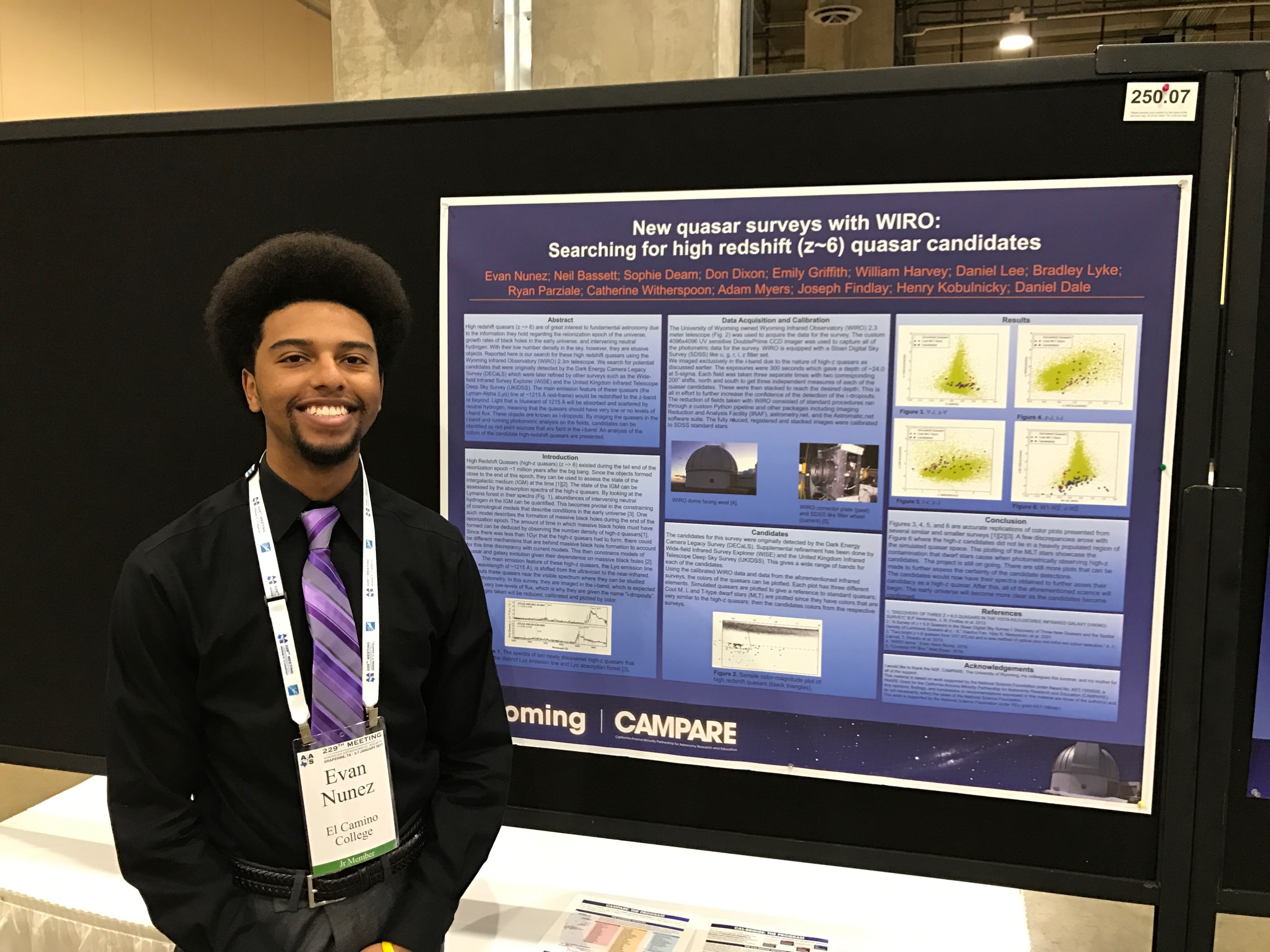Research Projects
REU = Research Experience for Undergraduates
Updated July 11, 2022
Caltech Hi-z Galaxies Group
My thesis is being advised by Chuck Steidel and Evan Kirby and is focused on directly observing the baryon cycle in individual galaxies at z=2-3-the peak of cosmic star formation. The baryon cycle describes how the baryons from the interstellar medium (ISM), circumgalactic medium (CGM), and intergalactic medium (IGM) all interplay with one another. At a high level galaxy formation starts with accrection of metal-free gas from the IGM where it is converted to stars, the massive stars return metals, momentum, and energy into the ISM that scales up to being ejected into the CGM (and IGM) where, after some time, it falls back onto the galaxy. Since the CGM is so diffuse it is difficult to detect it via emission (unless the galaxy emits Lya emission) so we make use of background quasars that intersect the galaxy CGM on its way to us because the CGM will absorb away the continuum of the quasars-both HI and metals. This, in combination with observing the galaxy ISM via its stellar/nebular emission gives us a direct detection of the baryon cycle. For more information and other considerations see my Candidacy Report and Candidacy Presentation
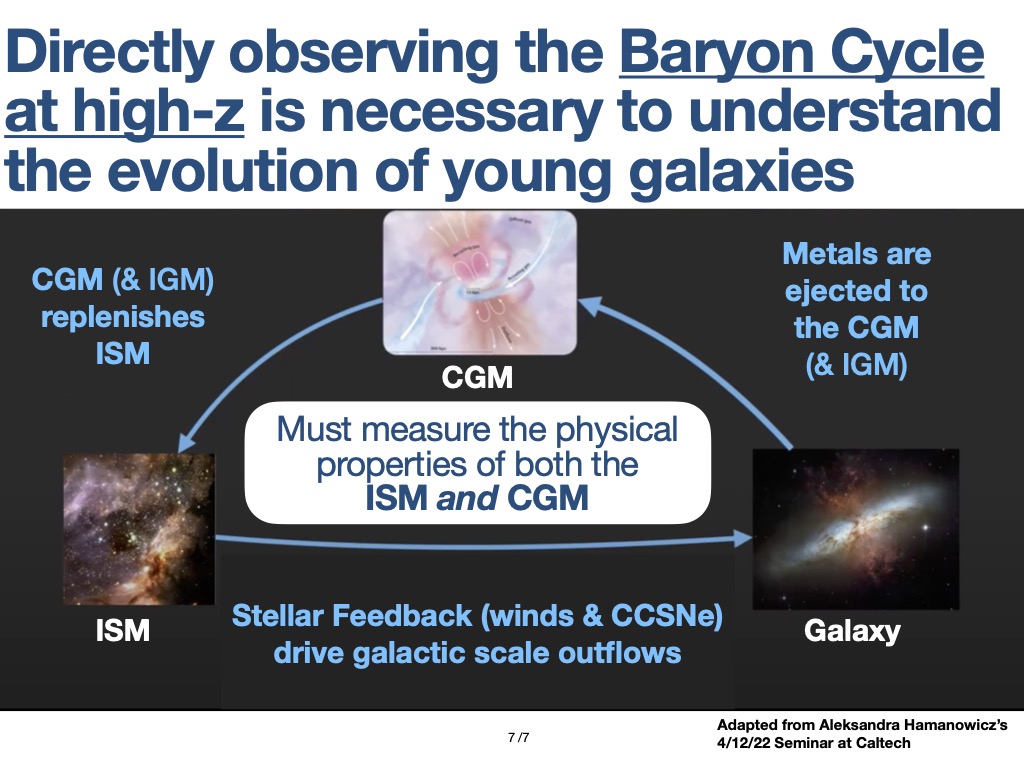 Caption: Ilustration of the individual baryon cycle of galaxies.
Caption: Ilustration of the individual baryon cycle of galaxies.
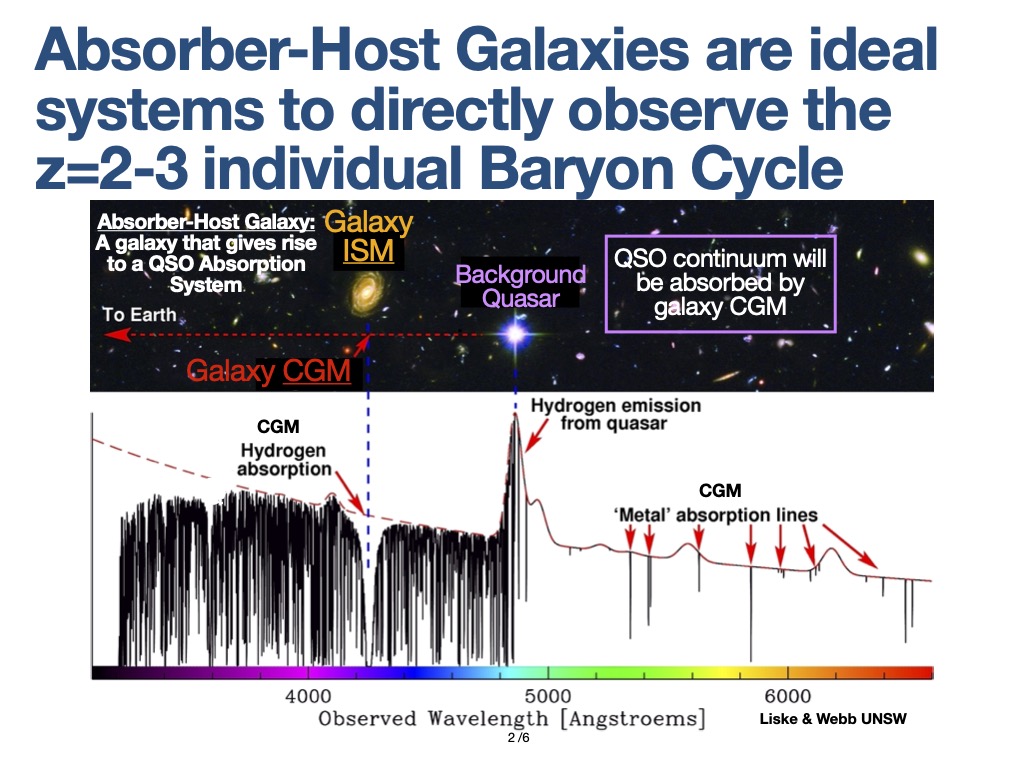 Caption: Physical setup of how we study the ISM and CGM of high-z galaxies. The ISM is deteced by emission from the metals in the gas phase and the CGM is detected by Lyman Alpha emission (for hydrogen) and quasar absorption (for both hydrogen and metals).
Caption: Physical setup of how we study the ISM and CGM of high-z galaxies. The ISM is deteced by emission from the metals in the gas phase and the CGM is detected by Lyman Alpha emission (for hydrogen) and quasar absorption (for both hydrogen and metals).
I recently presented at AAS 240 in Pasadena, CA (right down the street from Caltech) on progress that I have made on the bright Lyman-Break Galaxy (LBG) towards quasar Q2233+131. It turns out detecting the ISM of these galaxies is difficult because of how bright the background quasar is. Additionally, the revolutionary insrument that we use to find these galaxies, known as KCWI (Keck Cosmic Web Imager), gives us datacubes that contain a spectrum for every spaxel (spatial pixel) which means that we have to be careful with how we remove the quasar because it will not be the same at all wavelengths-spatially or spectrally. As a result I have been exploring different approaches to subtracting the quasars from our datacubes and the results from my currently preferred approaches is below . The next task is to synthesize the many datasets that we have of this galaxy to understand how the hydrogen and metals are propogating from the galaxy to CGM (and IGM) and back.
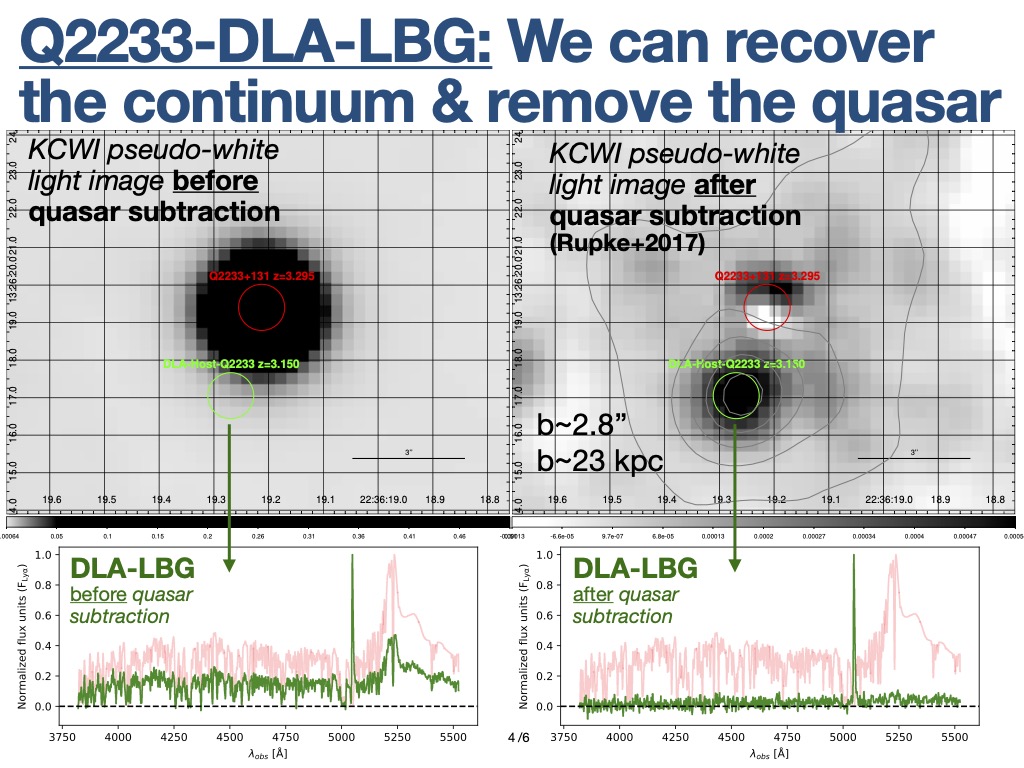 Caption: Left: QSO 2233+131 and galaxy LBG before the quasar is subtracted. The galaxy cannot be seen in the continuum due to glare from the quasar. Right: System after quasar subtraction. The galaxy can now be seen in the continuum.
Caption: Left: QSO 2233+131 and galaxy LBG before the quasar is subtracted. The galaxy cannot be seen in the continuum due to glare from the quasar. Right: System after quasar subtraction. The galaxy can now be seen in the continuum.
Notre Dame Galactic Archaeology Group
My first project at Caltech was with Evan Kirby (Caltech Galactic Archaeology Group) and Chuck Steidel on placing empirical constraints on the core collapse supernova yields of zero-metallicity stars. We made use of near-pristine (i.e., contain very few metals) clouds of hydrogen called very metal poor damped lyman alpha absorbers (VMP DLAs). For more context check out the paper here, Qual Report and Qual Presentation.
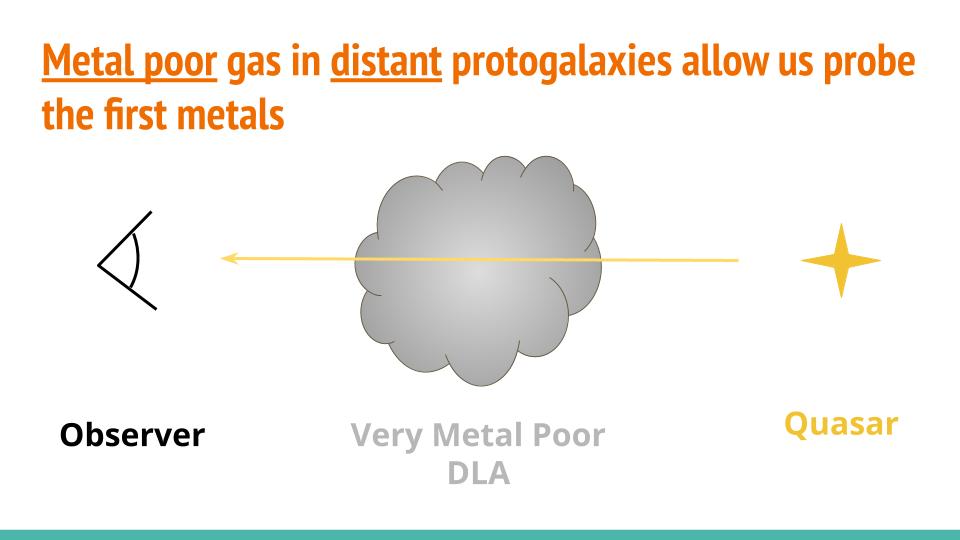
Caption: Cartoon illustration of a VMP DLA. The metals that exist in this cloud would have had to come from an episode of early star formation that contained stars that were almost metal-free.
Smithsonian Astrophysical Observatory REU
Summer 2018 I researched at the Harvard-Smithsonian Center for Astrophysics with Professor Charlie Conroy and Postdoctoral Fellow Joel Leja on using Flexible Stellar Population Synthesis to constrain the ionizing photon budget of massive stars in distant galaxies. This was by far the most productive summer that I have had since this was my third consecutve astronomical research experience. I had a very fun and thoughtful summer because of the friends I made and my affiation with the Banneker-Atzlán Institute. I will present this research at the 233rd American Astronomical Society (AAS 233) National Conference in Seattle, WA January 2019. A requirement of the SAO REU is to write a paper/report on the research concucted over the 10-week long summer. This made the research cement into my head and encouraged deeper understanding of the topic.
Click here for the paper/report
Click here for the full poster
 Caption: Title page of the paper
Caption: Title page of the paper
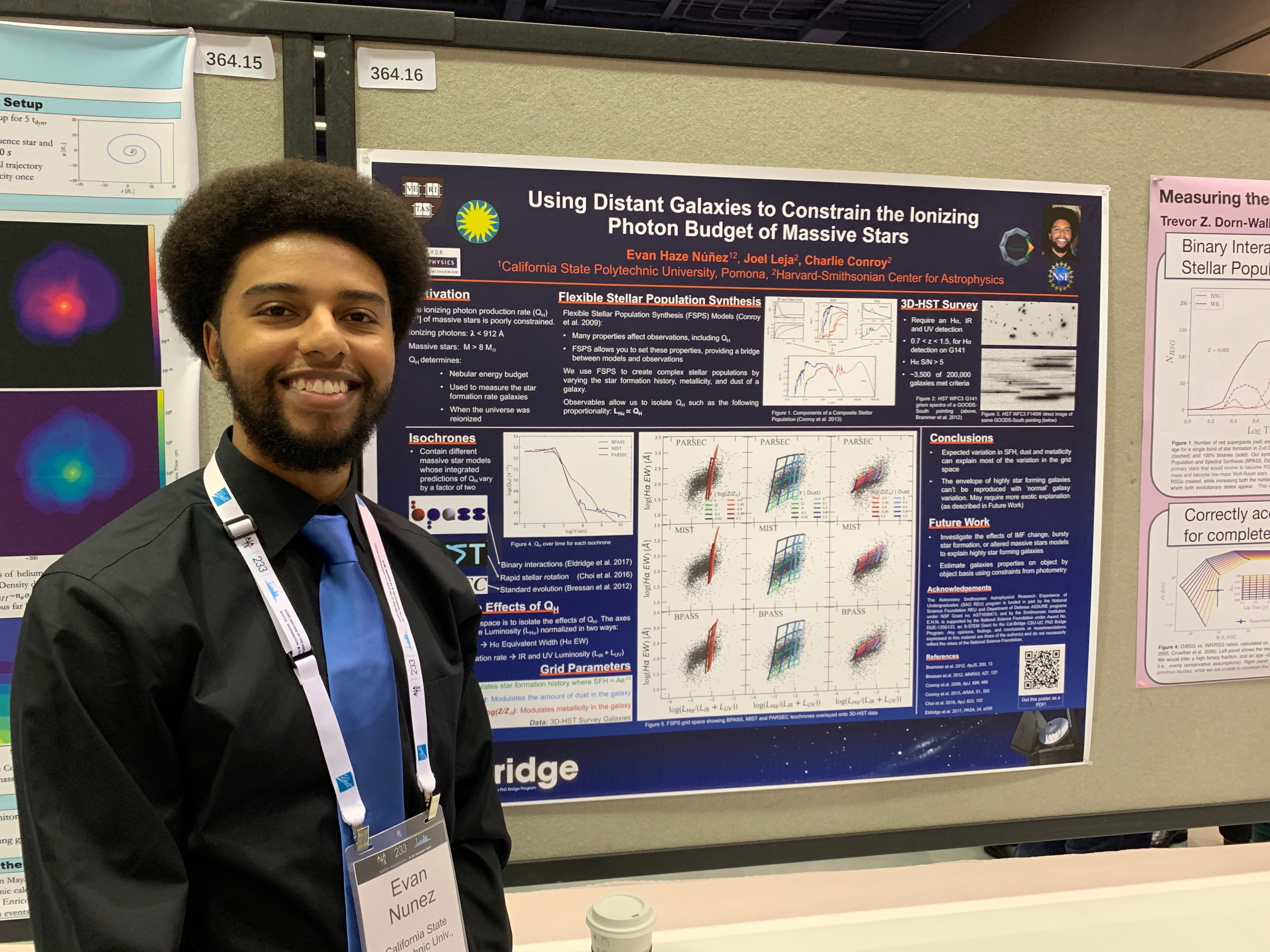 Caption: Presenting my poster at AAS 233 in Seattle, WA.
Caption: Presenting my poster at AAS 233 in Seattle, WA.
Cal Poly Pomona
Summer 2017 I began researching at my home institution Cal Poly Pomona with Professor Matthew Povich and Postdoctoral Fellow (now Assistant Professor) Breanna Binder on the characterizing the X-ray properties of Intermediate-Mass Pre-Main-Sequence Stars. I presented this work as a poster at two different conference. The first was at the AAS 231 in National Harbor, MD where I was named one of five undergraduates out of 100 to be a medalist for the Chambliss Astronomy Achievement Award. The second time was at the Chandra Workshop on Accretion in Stellar Systems in Cambridge, MA while I was researching at the CfA (above). This was my first topical conference and it was a blast! I recently submitted this work to AJ where it was accepted and is now awaiting publication. Check out the preprint here
Click here for the full poster
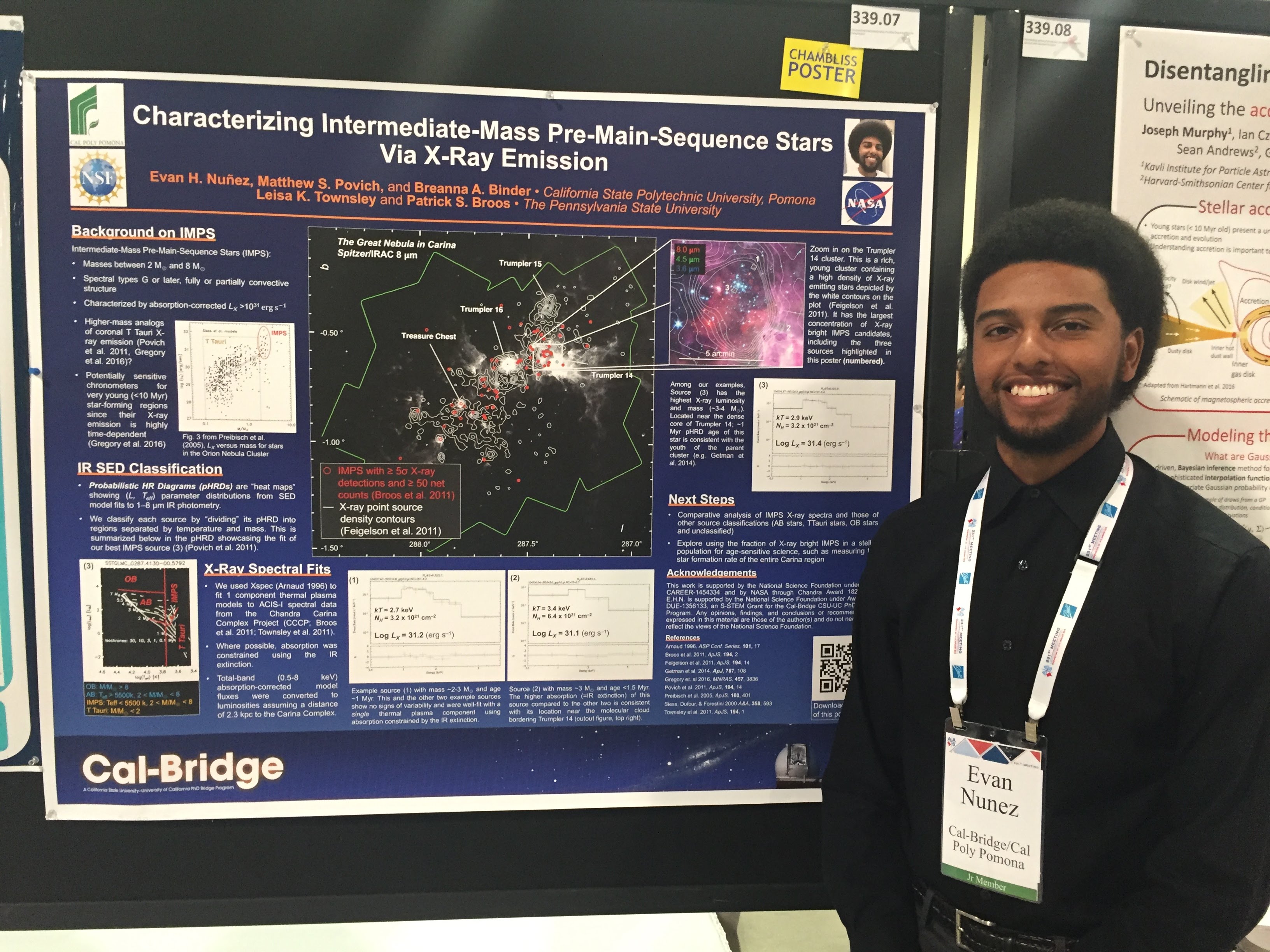
University of Wyoming REU
Summer 2016 I researched at the University of Wyoming with rofessor Adam Myers and Postdoctoral Fellow Joe Findlay on searching for high redshift-quasar candidates. The majority of the summer was spent observing, reducing data, and calibrating the data so that we could start data analysis. I lived the observational astronomers dream by being observing for ~30 nights that summer! Almost every night was enjoyable except when there were clouds and when we had to take morning flats. Bleh. Overall, this was a great first experience for astronomical research. I presented this research at AAS 229 in Grapevine, TX.
Click here for the full poster
